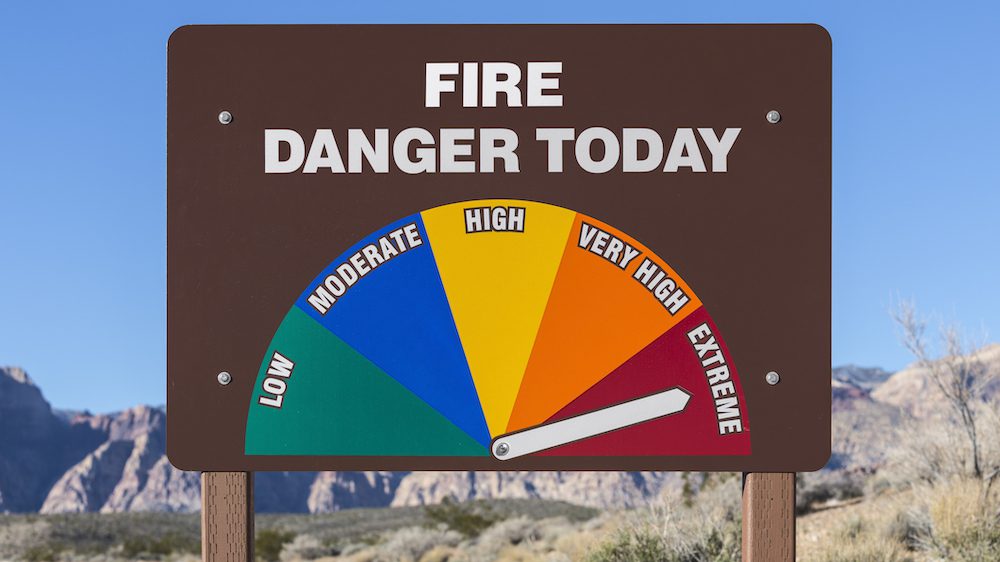
Getty Images
After last year’s record-setting wildfires, which burned over 10 million acres, experts predict this year’s wildfire season will be just as dangerous. Scorching temperatures and drought conditions make it nearly impossible to prevent some fires, but if you live in a place that’s considered at risk for wildfires, you’re probably concerned about how to protect your home.
While there are many obvious ways to help stop the spread of wildfires (mainly, by respecting fire bans), there are also some steps you should take to mitigate the risk of fires.
We spoke to wildfire and fire mitigation experts to pinpoint the actions you can take to protect your home and your neighborhood going up in flames this season. Here’s what they had to say.
What is fire mitigation?
“The goal of fire mitigation is to alter how a fire burns throughout a property and to reduce the likelihood of that fire negatively impacting lives, structures, and even the forest,” says wildfire expert Charlie Landsman, of the Wildfire Adapted Partnership.
In other words, fire mitigation doesn’t necessarily seek to stop a wildfire (although it is preventive by nature), but rather to control how and what it might burn. Since the vast majority of wildfires are started accidentally by people (as many as 90%, according to the U.S. Department of the Interior), having a well-mitigated neighborhood and property could make the difference between losing your home to a fire and having it spared.
Mitigation isn’t just good for preventing damage to your property, it also helps firefighters stop fires that are underway. By removing and disposing of flammable organic matter (extra sticks, pine needles, leaves, even low-lying scrub), you’re taking away a lot of the fuel that allows wildfires to consume millions of acres.
Wildfire mitigation techniques
Mitigating your property and neighborhood might sound complicated, but it’s really not. Here are three steps to get your home and property properly mitigated this fire season.
1. Create defensible space: The first step in mitigating your property is to create defensible space around your home.
“Defensible space is the area surrounding your home that can help protect it from loss or damage in a wildfire,” says Erin Johnson, wildfire programs manager for the Theodore Payne Foundation. “Depending on your location, proximity to neighbors, terrain type, and habitat, defensible space is typically defined as a radius of 100 feet surrounding a structure.”
To create a defensible space around your property, you’ll want to remove any fuel within that perimeter.
“Clear grasses and shrubs below larger trees, and trim trees up to reduce the chances of fire carrying from the ground into the tops of trees,” says Landsman.
Don’t stack firewood on a deck or next to the home since embers can gather in the firewood stack, ignite it, and then ignite the deck or home itself.
Don’t forget to clean out pine needles accumulating in your gutter or on your roof, or even the tree branches growing over your deck. Anything that could help a fire spread from your property to your home has to go if you plan on having a truly defensible space.
2. Landscape wisely: Another key step to keeping your home safe is choosing wisely when it comes to landscaping.
“California native plants have remarkable characteristics that provide protective services to homes and structures during and after a fire,” says Johnson. “The massive canopy of a coast live oak can act as a shield for your home, extinguishing embers that travel miles ahead of a fire. Likewise, an evergreen ground cover such as coyote brush can help diffuse embers rolling toward your home. The deep roots of many species such as toyon can help stabilize slopes, preventing mudslides after a fire.”
What makes native plants so robust?
“Native plants can hold their hydration and health better than non-native plants,” says Cassy Aoyagi, president of FormLA Landscaping. “This makes them better at resisting high, dry heat. Non-natives, by contrast, can escape our gardens and become fuel for fire.”
3. Help out your neighbors: An important aspect of fire mitigation that many people forget, is that it should be a collaborative effort among neighbors.
“Landscaping for wildfire resilience is one small action we can take as individuals to prepare for wildfire,” says Johnson. “But to achieve true wildfire resiliency, our actions need to take place on the community scale.”
So go ahead and coordinate a group fire mitigation cleanup for that neglected park, or contact your elderly neighbors to see if they need help clearing some brush. After all, it takes a village to reduce wildfire risk.
The post It’s Wildfire Season: Here’s How To Practice Fire Mitigation and Protect Your Home (and Neighborhood) appeared first on Real Estate News & Insights | realtor.com®.
No comments:
Post a Comment